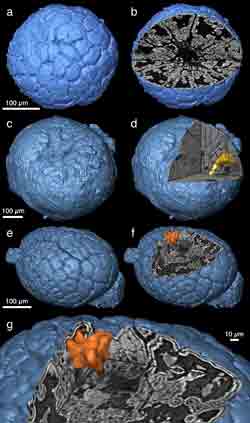Evolution of a penis worm

Cleavage-stage embryos from the Lower Cambrian, Southern China, comparing biological detail with non-biological (diagenetic) artefacts.
Writing in the journal Nature, Dr Phil Donoghue and colleagues reveal the various developmental stages of fossilised embryos, from the first splitting of cells to pre-hatching, using synchrotron-radiation X-ray tomographic microscopy (SRXTM).
In one instance this has exposed the internal anatomy of the mouth and anus of a close relative of the living penis worm. Another case has revealed a unique pattern for making embryonic worm segments, not seen in any animals living today.
Phil Donoghue, from the University of Bristol, said: “Because of their tiny size and precarious preservation, embryos are the rarest of all fossils. They are just gelatinous balls of cells that rot away within hours. But these fossils are the most precious of all because they contain information about the evolutionary changes that have occurred in embryos over the past 500 million years.”
This work has enabled the reinterpretation of previous data on fossilised arthropod embryos, showing that they are similar to those found in modern arthropods (insects and crustaceans). This suggests that arthropod evolutionary history must be pushed further back in time than previously thought.
Using SRXTM at the Swiss Light Source of the Paul Scherrer Institute in Switzerland, the team obtained complete three-dimensional images of the fossilised embryos at sub-micrometre resolution. The scans from these experiments are then manipulated in a computer to reconstruct the internal anatomy of the fossil embryos, unlocking the finest details of their preserved anatomy and revealing their hidden secrets.
The present study demonstrates the feasibility of the method for a variety of questions concerning developmental processes in early fossil animals.
Media Contact
More Information:
http://www.bristol.ac.ukAll latest news from the category: Life Sciences and Chemistry
Articles and reports from the Life Sciences and chemistry area deal with applied and basic research into modern biology, chemistry and human medicine.
Valuable information can be found on a range of life sciences fields including bacteriology, biochemistry, bionics, bioinformatics, biophysics, biotechnology, genetics, geobotany, human biology, marine biology, microbiology, molecular biology, cellular biology, zoology, bioinorganic chemistry, microchemistry and environmental chemistry.
Newest articles

“Nanostitches” enable lighter and tougher composite materials
In research that may lead to next-generation airplanes and spacecraft, MIT engineers used carbon nanotubes to prevent cracking in multilayered composites. To save on fuel and reduce aircraft emissions, engineers…

Trash to treasure
Researchers turn metal waste into catalyst for hydrogen. Scientists have found a way to transform metal waste into a highly efficient catalyst to make hydrogen from water, a discovery that…

Real-time detection of infectious disease viruses
… by searching for molecular fingerprinting. A research team consisting of Professor Kyoung-Duck Park and Taeyoung Moon and Huitae Joo, PhD candidates, from the Department of Physics at Pohang University…





















